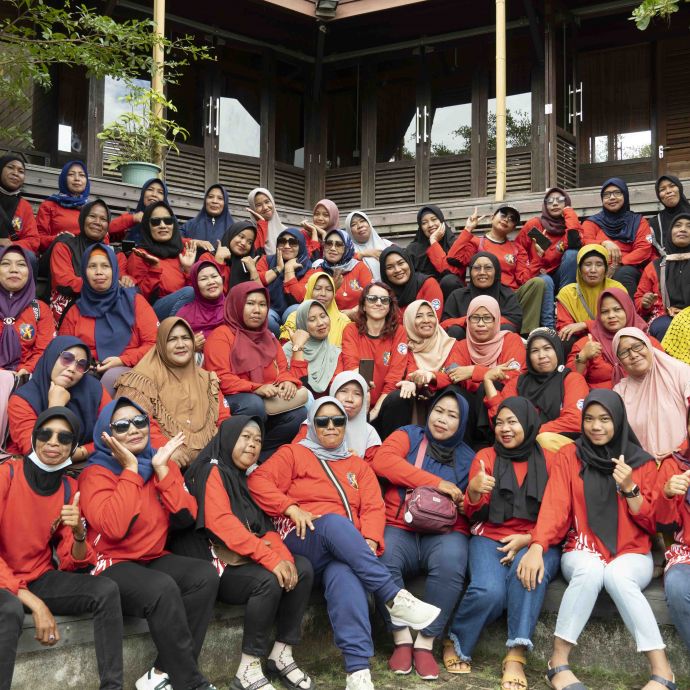Orangutan
Intro
The plight of the orangutan in Indonesia has reached a critical stage, with the survival of all three species under serious threat. These critically endangered primates are suffering and dying as a result of habitat loss, primarily for palm oil production and other industrial scale agriculture, as well as through hunting.
International Animal Rescue is tackling the problem on every level, including the rescue and rehabilitation of individual animals and their reintroduction into the wild; forest protection and reforestation; community outreach and education, and collaboration with all stakeholders to secure the long term future of the species, the local communities, and the forest habitat on which animals and people depend for survival.
If orangutans are to survive in the wild, it is vital that there is enough forest left to provide them with food and shelter and enable them to move from one patch of forest to another, to ensure breeding opportunities and genetic diversity. IAR Indonesia works with local and national governments, the private sector, other NGOs and consultancy firms, and international certification schemes to facilitate this.
The team is based in West Kalimantan – a province in the southern, Indonesian part of the island of Borneo. At IAR’s conservation centre in Ketapang, orangutans that have been taken from the forest and kept as pets undergo lengthy rehabilitation so that they can return to the wild and live as nature intended.
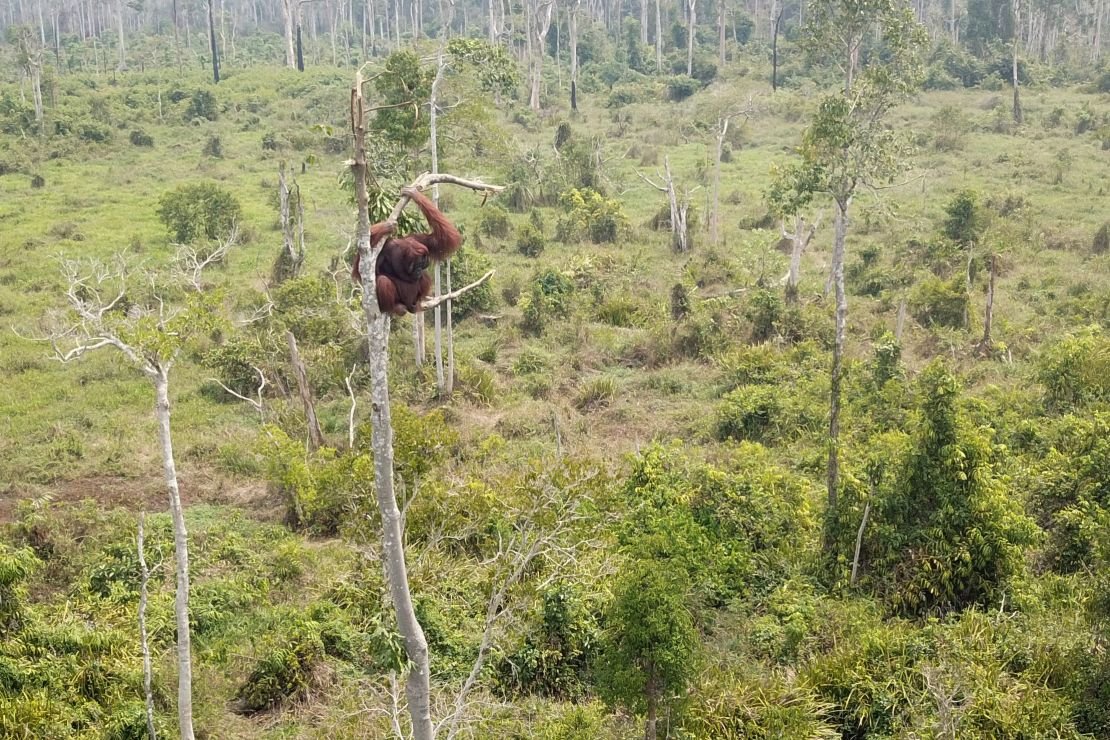
The Orangutan Conservation Centre
In 2013, IAR established the first rescue and rehabilitation centre for orangutans in the province of West Kalimantan. The centre is in the village of Sungai Awan (often abbreviated to Sei Awan), roughly 30 minutes’ drive from the town of Ketapang.
The site was selected because of its rural location and because it is not far from Ketapang where most of our staff live. The goal of the centre is to provide as natural an experience for the orangutans as possible. The land on which the centre was built contained a large expanse of secondary forest and peat swamp forest, which was considered appropriate for forest schools for the younger orangutans and islands for the older orangutans in the pre-release stage of rehabilitation.
Since first moving into the centre we have been able to acquire more land surrounding it and the site now covers 150 hectares. The facility houses all the rescued orangutans and is also where we have our office, as well as being the base from which we run our conservation programmes. Near the office, at the front of the land, is a guesthouse for visiting researchers and volunteers. As you move towards the back of the site, away from the visitor area, you reach the clinic. Thanks to kind donations from members of the public and private companies, we have one of the most well- equipped clinics in Indonesia. Adjacent to the clinic is the quarantine area, and then the cages. Further north on the land are the forest schools and the islands. We currently have four islands, on which orangutans in the final stages of rehabilitation live.
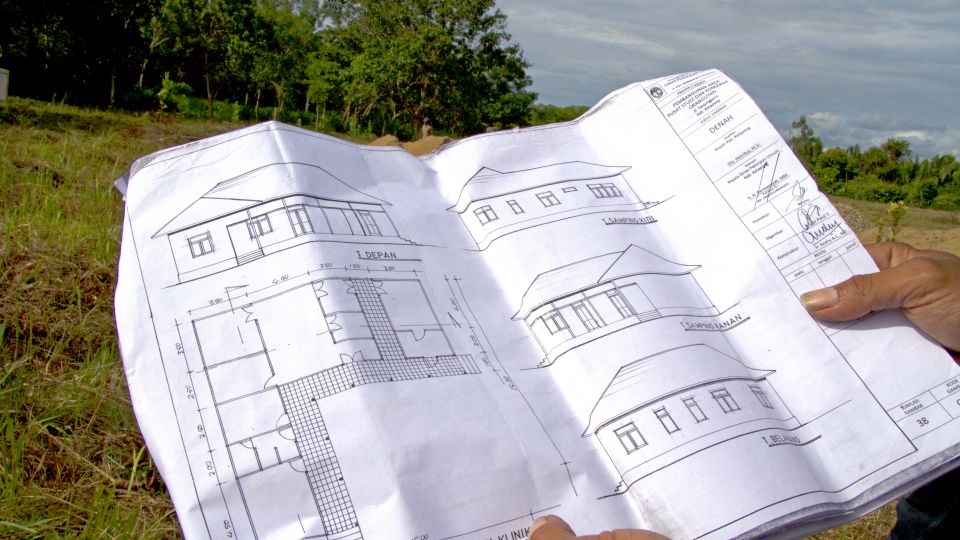
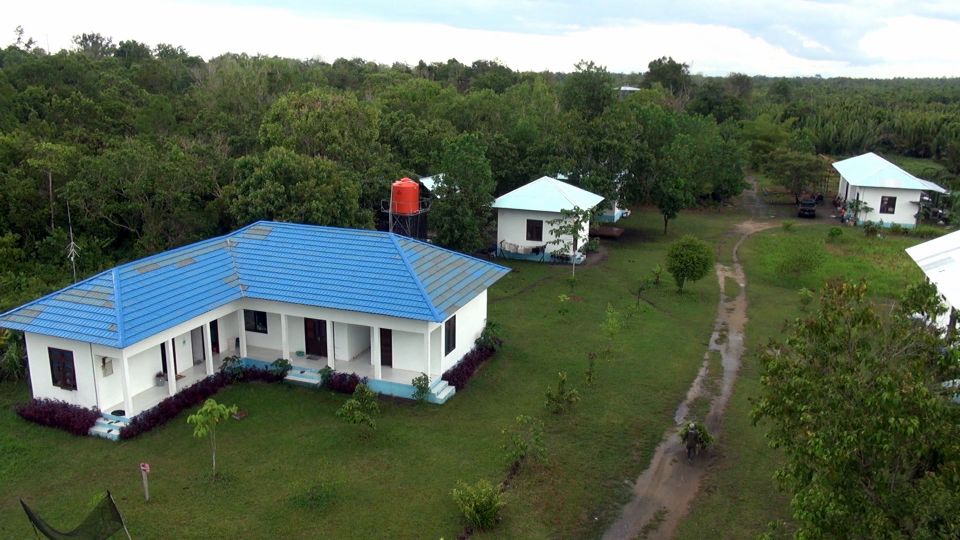
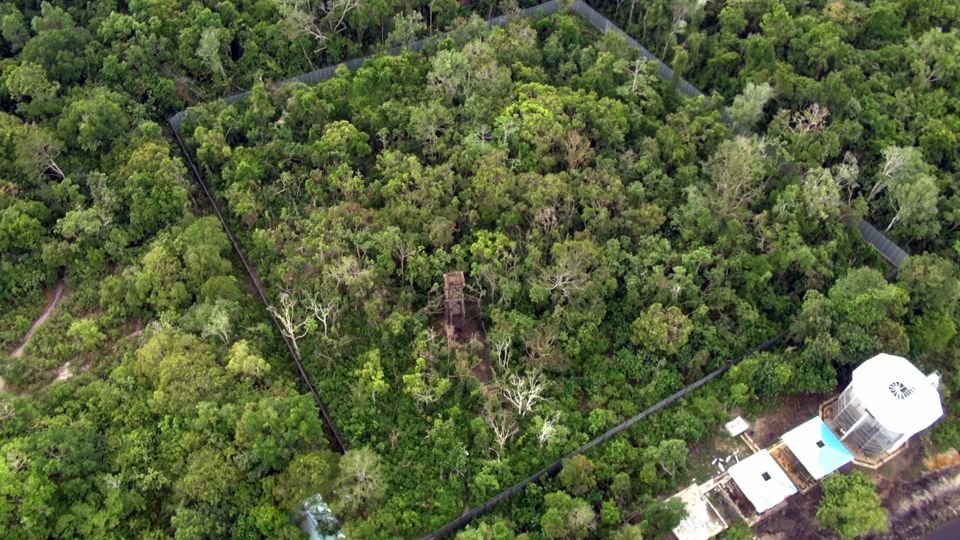
Our work
The team at IAR Indonesia incorporates an holistic approach towards the conservation of one of humanities closest cousins. By working with the regional government, we have restored destroyed areas of rainforest, educated local communities and repopulated a species on the brink of extinction. The fight to save the orangutan is multi-faceted and ever changing - take a look at how we’re rising to the challenge.
-
Protection
As forest is degraded and humans move ever further into orangutan habitat, instances of human-orangutan conflict (HOC) increase. Such conflict can occur on large scale plantations and small-scale smallholdings or local farms, and in both instances occurs when orangutans are forced out of degraded forest and travel into plantations in search of food, or are merely attracted out of the forest by the sudden appearance of an appetising and easily accessible food source. HOC can often result in the death or capture of the orangutan, and the increase in HOC seen in Borneo and Sumatra, as the human population has grown and more land has been allocated for agriculture, is considered one of the greatest threats to their survival.
Orangutan Protection Unit
To combat this threat, in 2011 IAR established the first Orangutan Protection Unit in West Kalimantan. The team immediately began investigating the extent of the HOC in West Kalimantan, examining the causes and the different mitigation methods currently used. It was immediately clear that, unless HOC could be mitigated, we would need to rescue more and more orangutans, and the species would be in an even more dire state.
We immediately began training people living near orangutan habitat. The training has two components: training in the manufacture of the HOC mitigation device and understanding basic orangutan movement patterns, so people have a better understanding of how orangutans behave, where they are likely to travel and how to move them away from possible sources of conflict. We teach people how to make hand-held firecracker cannons (manufactured from bamboo and tin, using calcium carbide to produce a loud noise when detonated), to steer the orangutan back into the forest or away from humans and/or crops. Our team have successfully been using this methodology for a number of years and it has proved incredibly effective. Training is also provided in how to ‘cut off’ the pathway of an orangutan, steering it in the desired direction, i.e., from a garden or plantation and back into the forest.
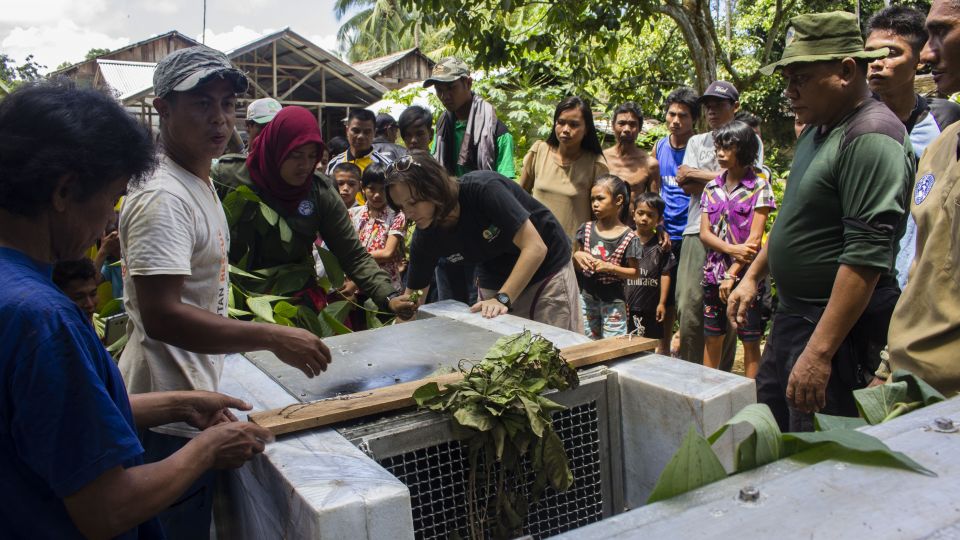
Community Prevention Units
In areas where HOC instances are high, we have established and trained Community Prevention Units. They have used the methods taught by our team to monitor orangutan populations in their local areas, helping other residents if orangutans enter their farms and reporting back to us if there are any instances of orangutans being killed. These units have been instrumental in mitigating conflict. They are an example of how we believe conservation projects should be managed by people from the community, working with people in their local area to protect local wildlife.
We have also taken our HOC mitigation training to local palm oil and timber companies, helping to establish and train conservation and orangutan monitoring teams on plantations. These teams help protect orangutans in and around plantations, steering them away from conflict situations and helping to enforce Best Management Practices that our team has developed with management. They also monitor orangutan populations and record sightings of individuals and nests, helping us to understand how many orangutans are living in these landscapes, and how far they are travelling.
-
Rescue
Rescuing orangutans is a difficult and challenging process, whatever the situation, and unless the orangutan is in a desperate situation or being kept as a pet, rescuing is always a last resort, and only carried out if every other option to keep the orangutan in the wild has been explored.
IAR does not have the legal authority to carry out rescues in Indonesia and all our rescues are conducted in collaboration with the local nature conservation agency of the forestry department, known as the BKSDA. It is only thanks to our good relationship with this, and other government departments that IAR is able to carry out its conservation work.
We are usually alerted to the presence of an orangutan in need of rescue by the BKSDA, by people contacting us or contacting one of our staff members who lives in their local area, by our Orangutan Protection Unit (OPU) or by one of the Community Prevention Units we have established in areas where we know orangutans are at risk.
Immediately upon being alerted to an orangutan in need of rescue, our team sets out to investigate, either rescuing the orangutan immediately, or doing an assessment of the situation and determining how many members of staff are needed. Each rescue team comprises enough field staff to carry the equipment and the orangutan once it has been rescued, one or two vets and, if necessary, a member of our Orangutan Protection Unit to help in the case of any resistance or community issues during the rescue. All rescues are attended by a member of the BKSDA.
Whether the rescue is a young baby kept as a pet or a wild orangutan in need of being darted and caught from a tree, our team always does a health assessment in the field, and takes details of the location of the rescue, details of the orangutan and the context of the rescue. Orangutans that are anesthetised during the rescue have a microchip inserted into the back of the neck, so they can be easily identified in the future. If this doesn’t happen in the field, it will be done at our clinic.
If our team is rescuing a wild orangutan and it is believed that the orangutan can be directly translocated to another area of forest immediately, without having to be brought to our centre, the rescue will only be carried out once permission has been granted from the relevant management authority of the desired release site. Once the orangutan has been captured, the translocation will only be given the green light once a health check has been carried out, and our vets are satisfied that the orangutan is in good health and strong enough to survive in the wild.
-
Rehabilitation
Orangutans have the longest inter-birth interval, and the longest period of infant dependence, of any land mammal. Infants stay with their mothers for between six and eight years. This period of dependence and the mother-infant bond is essential if young orangutans are to learn how to survive in the forest. In many ways, the orangutan species’ semi-solitary nature makes it easier to rehabilitate and reintroduce them into the wild, as unlike group-living primates, we do not need to establish social groups in captivity and can release them as soon as we are confident they have learnt the skills necessary to survive. Learning these skills however, is a difficult and lengthy process.
- Quarantine
As soon as orangutans arrive at the centre, they are placed in quarantine for eight weeks. Orangutans are closely related to humans and they are susceptible to many human diseases. As almost all the rescued orangutans come from human-dominated landscapes, disease transmission is a serious risk and there is a possibility of such diseases spreading throughout the centre. All orangutans are given a risk assessment and tested for more than 40 diseases, including those of bacterial, viral, parasitic, and fungal origin.
- Pre-school
After being declared disease-free, the orangutan is moved to the enclosure appropriate for its age and skill level. Very young babies are taken to pre-school, a forest enclosure where they can mix with other orangutans of a similar age. Dedicated Indonesian staff act as their surrogate mothers, caring for them, feeding them and encouraging them to spend time off the ground, on the climbing platform and in the trees. Orangutans in pre-school are usually under two years of age and, although very young, some of the braver ones will sometimes stay in the forest overnight. However, the majority return to their cages.
- Baby school
Orangutans of between the ages of two and four attend baby school, where they spend time in a separate forest enclosure and are encouraged to live more independently, making nests, spending more time off the ground and foraging for their own food. They are also encouraged to spend the night in the forest, although we always allow orangutans back in to the cages if that is what they prefer.
- Forest school
Forest school follows on from baby school. Most of the orangutans in forest school are four years old or more. They have already gained independence from their keepers and spend more time alone or with other orangutans. They stay in the forest overnight and are encouraged to build nests at night to sleep in. All orangutans at our centre in the final stages of rehabilitation are monitored, and data is collected and later analysed and compared to data from wild orangutans, to select the most appropriate candidates for release. Behavioural data collection starts in forest school.
- Pre-release island
After graduation from forest school, orangutans are moved to one of our four? islands. These islands are bordered by fences or moats and mimic, as much as possible, wild forest into which the orangutans will eventually be released. Here they develop their nest building and foraging skills and are monitored from dawn to dusk. The most competent and independent orangutans are selected for release. They are fitted with microchips for tracking post-release and taken to our release sites.
As rehabilitation is so complex, and little is known about the survival rates of released orangutans, despite orangutans having been released for over 40 years, the team constantly reviews and refines its methods, taking into account the latest research and our successes and failures. We hope our methods fully equip our orangutans for life back in the wild.
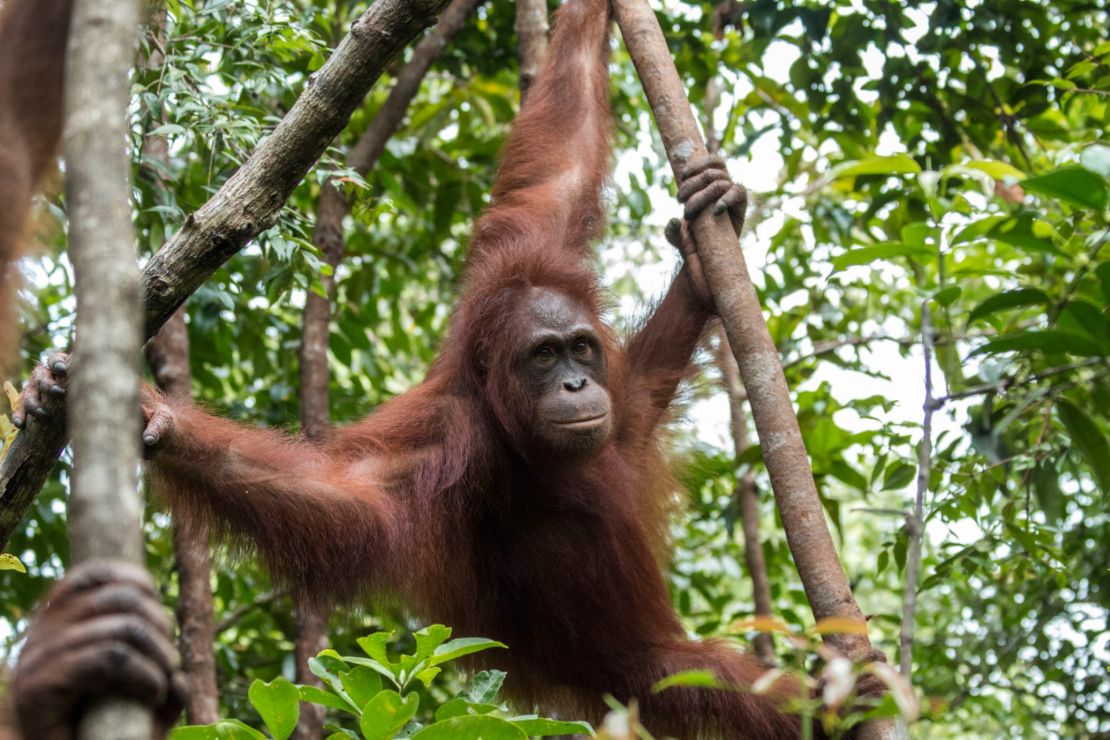
-
Release
The overall aim of our rehabilitation programme is to release as many suitable orangutans as possible into areas where they have become extinct or where the carrying capacity of the area is so low that the resident orangutans are at risk of extinction or inbreeding.
IAR’s rehabilitation efforts are all conducted in accordance with the Guidelines for the Reintroduction of Great Apes (2007) by the IUCN (International Union for the Conservation of Nature.) These guidelines stipulate that great apes must only be reintroduced into areas where they will be protected and not at risk from any external threats.
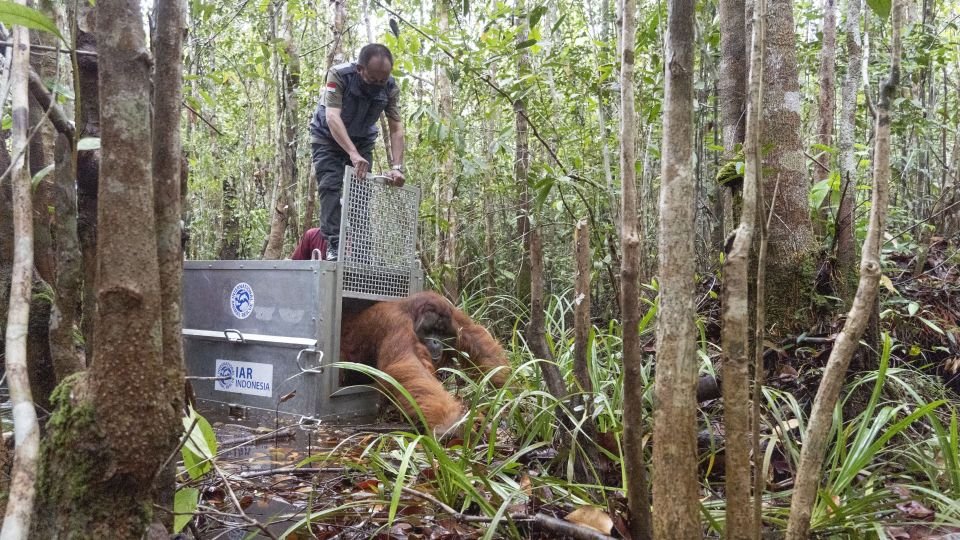
The reintroduction process differs greatly depending on the age and background of each individual animal. Wild orangutans rescued from conflict situations or degraded habitats that are deemed healthy after a medical check in the field or at our centre, are released back into the wild as soon as possible, a process called ‘translocation.’ In this instance, the orangutans aren’t monitored post-translocation as they are still essentially wild and their period in care is so short that there are not considered to be any impediments to their survival.
The second process is for animals that have been rescued from conflict situations, degraded habitat or the pet trade and have had to undergo a significant period of rehabilitation, and are released only after extensive pre-release monitoring and behavioural data collection and analysis has shown that they exhibit behaviour that mirrors wild orangutan behaviour. In these instances, orangutans are released and monitored for a period of up to two years, to ensure they are surviving in the wild, adapting to life in the wild, and to determine how they are socialising with wild orangutans. Data is also collected on the phenology of the forest they are released in to determine if there is enough food for them to eat and establish whether their presence is having any impact on the forest.
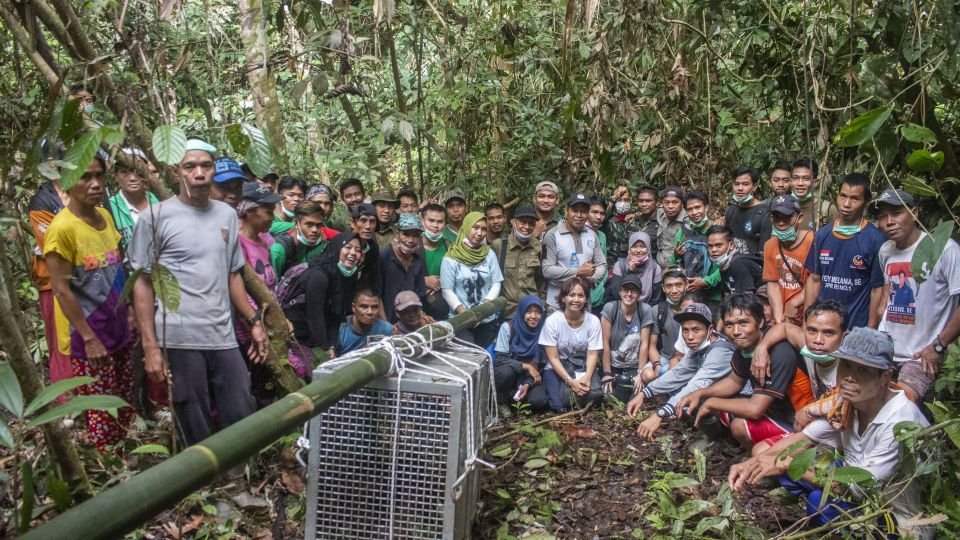
In both cases, it is imperative that forest is found in which to release them, and the forest has a population of wild orangutans small enough to cope with additional individuals and enough fruiting trees to sustain them. It must also, crucially, be protected, free of any external threats and our programme must have the support of the people living in the vicinity of the release site. While the political and social context of Indonesia means there are always threats to natural forests, in the past IAR has conducted extensive surveys and we now release our translocated orangutans into two areas: Gunung Tarak Nature Reserve and Bukit Baka Bukit Raya National Park.
Bukit Baka Bukit Raya National Park is a 181,000 hectare national park that has a very small and potentially non-viable resident wild orangutan population, which is in need of reinforcement. Most of the forest in this park is high elevation but there is sufficient low elevation forest to support an orangutan population. This lowland forest is contiguous with a larger area of forest, particularly across the provincial border in Central Kalimantan, and provides opportunity for future population growth and emigration. The high mountains of this area also provide a natural border to keep the founder population near the release site. It is also far enough from human dwellings, farms and roadways to minimise the chance of Human-Orangutan Conflict (HOC) occurring. Finally, and of great importance, this forest is already protected as a National Park and we have full support from the park authorities and the local people.
Gunung Tarak Nature Reserve stretches from the South East corner of Gunung Palung National Park down to the North East corner of the Sungai Putri forest. While its official area is 23,644.03 hectares, approximately 5000 hectares of this is being used for agriculture, or is open land. The remaining land is mostly secondary dry dipterocarp forest, and secondary swamp forest. Its location means it is an important buffer zone for the much larger Gunung Palung.
-
Community outreach and education
Education through religion
In one of our most important developments, we have also launched a religious education project, using religious texts and leaders of the two predominant religions in the area, Islam and Christianity, to encourage followers to think more seriously about environmental issues. This project also has a component that involves working with Dayak elders. Although many Dayaks have converted to Christianity, they hold on to many traditional beliefs and customs, and working within these customs has been a useful way of increasing awareness among Dayak communities. This has been incredibly important, as Dayaks are the ethnic group in Kalimantan most likely to hunt orangutans.
It is vital that all conservation programmes are carried out in conjunction with educational activities. IAR began running education programmes in West Kalimantan as soon as we began our rescue and rehabilitation work. We provided information on orangutan conservation and the legality of ownership to people keeping orangutans as pets whenever we went to rescue them and we have always been at pains to talk to the local community about the work we are doing and why it affects them too.
When it became clear that we would have to expand our education activities substantially in order to reduce the rate of forest loss and orangutans arriving at our centre, we put together a specialist team of local education practitioners. The team, in collaboration with our Orangutan Protection Unit, travels to communities in or near orangutan habitat, schools, universities and popular social spots in Ketapang to spread our message.
Conservation camps
One of our most successful programmes involves our conservation camps, which take place in the forest of Pematang Gadung. These camps are targeted at local teenagers, to develop and foster their interest in conservation, encourage them to become active stewards in the protection of Ketapang’s natural resources, and show them how decisions they make in their everyday lives can impact on the environment. Each conservation camp lasts three days and includes many different interactive activities, games and presentations, with the main event occurring on the second day, when participants are taken into the forest for a trek, visiting three pre-prepared learning posts. Teams are divided into three learning groups, so they reach the forest learning posts at different times, reducing the noise impact on the forest.
The camps have been a huge success and many of the teenagers who have taken part have remained involved with IAR, forming local conservation groups. These groups have been instrumental in devising and implementing outreach activities to celebrate International Orangutan Day, and Orangutan Awareness Week, organising concerts, poetry competitions, film screenings, and sports competitions, to name but a few.
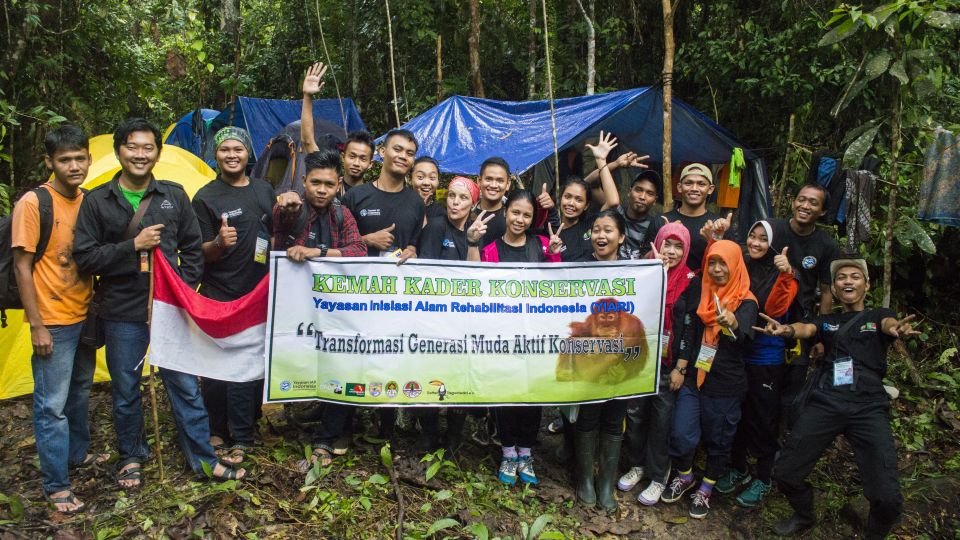
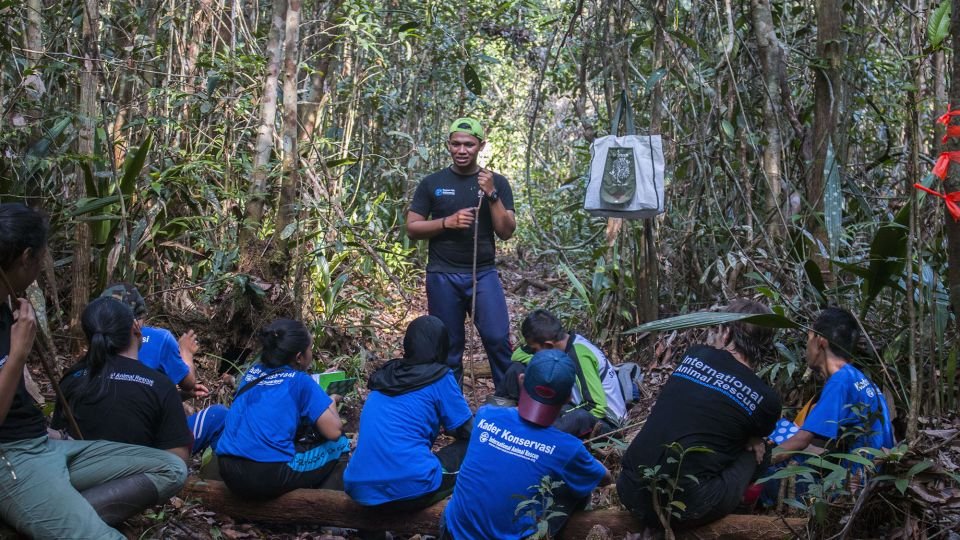
After-school programme
In 2016, IAR developed an after-school programme to provide a curriculum of environmental education, using outdoor activities to get our message across. The programme delivers materials about the forest, peatland, orangutans, the overall environment, the 5Rs and how to adopt a greener lifestyle. Every meeting begins with an ice breaker, to energise the children and get them in the spirit, and begins with games, including Running Forest, Find and Match, and Twister. The children taking part, usually pre-teens, are called our Pongo Rangers!
-
Sir Michael Uren Learning Centre
The Sir Michael Uren Learning Centre was established thanks to British philanthropist Sir Michael Uren who has supported the activities of International Animal Rescue for more than ten years and has a deep concern for sustainable development in the environment in Indonesia, particularly in Borneo. The Learning Centre was inaugurated on Wednesday, 10 July, 2019 and is located on a one-hectare site within the IAR office complex in Ketapang, West Borneo.
The centre brings together local communities, the private sector, academic research institutions, as well as government and non-government organisations, to build a better future for humans and nature. The mission for the centre is to build awareness, knowledge and ability through research and education to protect the environment and enable sustainable growth in Ketapang Regency.
Since it’s grand opening the centre has welcomed hundreds of children through its doors to learn more about orangutans and conservation as a whole. During the height of the COVID-19 pandemic the learning centre provided additional lessons and resources to local children who suddenly found their usual schools closed.
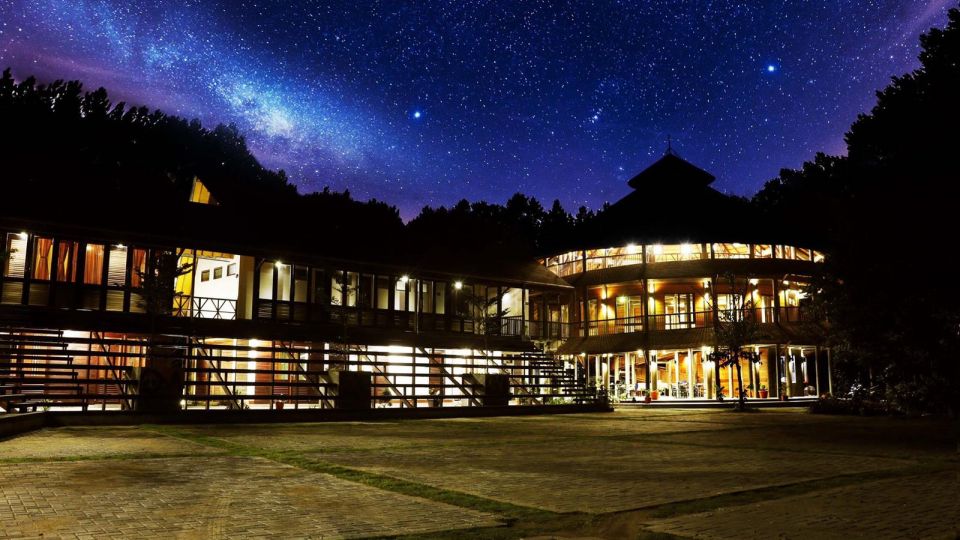
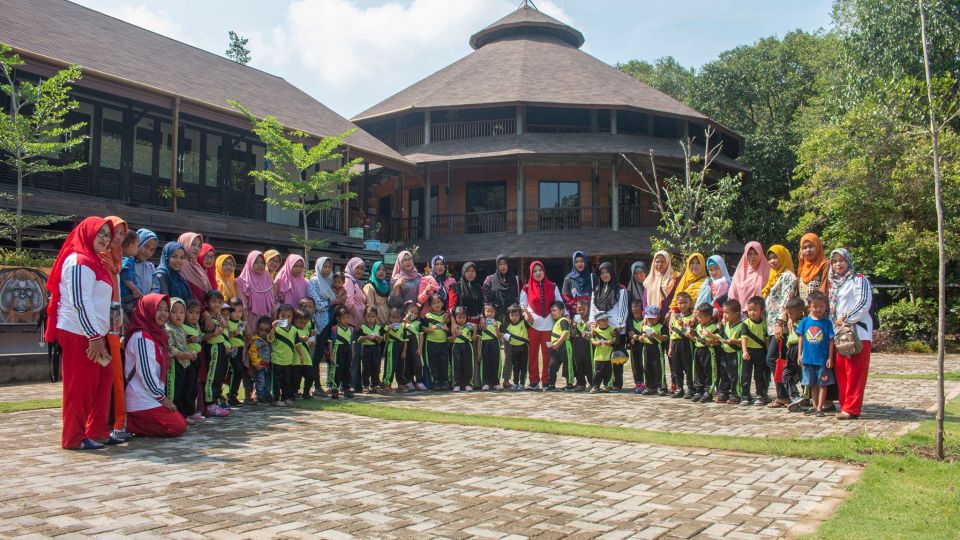
Orangutan News
Latest Orangutan News
-
Top Orangutan Facts
- In Malay and Indonesian orang means “person” and utan is derived from hutan, which means “forest.” Orangutan literally means “person of the forest.”
- Orangutans are divided into three separate species:
- Bornean orangutan (Pongo pygmaeus) – population estimated to be between 70,000 and 100,000.
- Sumatran orangutan (Pongo abelii) – population estimated to be about 14,000.
- Tapanuli orangutan (Pongo tapanuliensis) – population estimated to be about 800.
- All three species are listed as Critically Endangered on the IUCN Red List of Threatened Species, meaning they face an extremely high risk of extinction in the wild.
- The main threats to wild orangutan populations are illegal hunting and killing, and habitat loss primarily for palm oil and timber plantations.
- Orangutans are unique in the ape world. Of the four kinds of great apes (gorillas, orangutans, bonobos, and chimpanzees) only the orangutan comes from Asia. The rest come from Africa.
- Appearance – heavy, rather human-like body, with very long arms and grasping hands and feet. Dark grey skin and reddish hair.
- As the largest tree living mammal in the world, orangutans are the most arboreal of the great apes, spending most of their time in trees.
- Adult males develop distinctive cheek pads or flanges and make long calls that attract females and intimidate rivals.
- Orangutans are the most solitary of the great apes, with social bonds occurring primarily between mothers and their dependent offspring, who remain together for the first six to eight years of the infant’s life.
- Orangutans are among the most intelligent primates, using a variety of sophisticated tools and constructing elaborate sleeping nests each night from branches and foliage.
- Orangutans have tremendous strength, which enables them to swing from branch to branch and hang upside-down from branches for long periods of time to retrieve fruit and eat young leaves.
- An orangutan diet is made up of bark, leaves, flowers, a variety of insects, and most importantly, over 300 kinds of fruit.
- Lifespan – between 35 and 40 years. 50 years or more in captivity.






